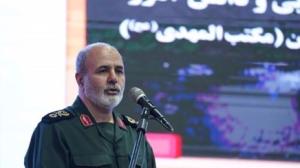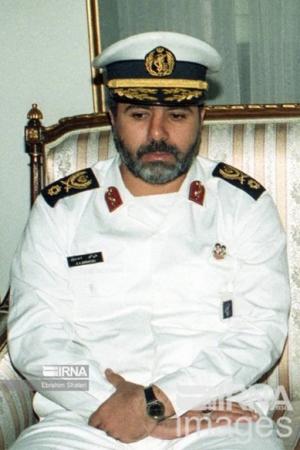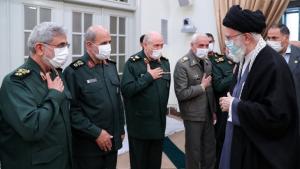Secretary of Iran’s Supreme National Security Council Dr. Ali Akbar Ahmadian
Download PDFPage Navigation
The appointment of Ali Akbar Ahmadian as the new secretary of Iran’s Supreme National Security Council (SNSC) signals more continuity than change in the Iranian establishment. He replaces Ali Shamkhani, his former boss, who held the post for around a decade as the second-longest serving SNSC secretary since 1979.
A Guardsman
 Ali Akbar Ahmadian
Ali Akbar Ahmadian
Ahmadian was born in the year 1961 in Kerman Province. He graduated with a degree in dentistry from the University of Tehran and then studied strategic management at National Defense University. During the Iran-Iraq War, he was deployed to several battlefronts, including in Bandar Abbas and in Khuzestan throughout Operation Fath ol-Mobin. Following his success at evicting Iraqi forces from Khuzestan, then-Commander-in-Chief of the Islamic Revolutionary Guard Corps (IRGC) Mohsen Rezaei named Ahmadian to the IRGC’s command council. Ahmadian also commanded the Nouh base and was intimately involved in the Tanker War, an experience which molded his outlook in spearheading the IRGC’s asymmetric military doctrine.
After the war, Shamkhani was selected to become the commander of both the IRGC’s and Artesh’s navies. Ahmadian served as Shamkhani’s deputy commander in the IRGC’s Navy. In 1997, after Shamkhani was appointed as defense minister in the administration of reformist President Mohammad Khatami, Ahmadian replaced Shamkhani as commander. During this time, Ahmadian signed onto a letter with other IRGC commanders threatening President Khatami over student demonstrations in 1999 stating that “we declare that our patience has come to an end, and we will not permit ourselves any more tolerance in the face of your inaction.”
 Ali Akbar Ahmadian
Ali Akbar Ahmadian
According to a profile of Ahmadian in the Tehran Times, “he was one of the main architects of the new and innovative naval force of the IRGC…and was one of the first theoreticians of the idea of asymmetric defense.” During Ahmadian’s tenure as deputy commander and then commander of the IRGC’s Navy, he and Shamkhani professionalized the force. This was especially needed following Tehran’s naval losses during the Iran-Iraq War. In the 1990s, the IRGC’s Navy acquired Chinese C-802 coastal defense cruise missile launchers and around 2000 C-14 missile patrol boats. Ahmadian was likely intimately involved in these transactions.
Ahmadian served as naval commander until he replaced Hossein Alaei as chief of the IRGC’s Joint Staff in 2000. Alaei had been a thorn in the side of Khamenei for years and his tenure at the IRGC’s Joint Staff was cut short after serving only for three years in contrast with his predecessor who served for eight. Alaei never again held command experience in the IRGC. Ahmadian was thus likely seen by Khamenei as a safer choice, which also could explain his promotion to SNSC secretary at a time when the Iranian system has become increasingly purged of dissenting views.
Ahmadian served for roughly seven years as chief of the IRGC’s Joint Staff and in 2007 was appointed by Khamenei to replace Mohammad Ali Jafari as head of the IRGC’s Strategic Center. Jafari went onto become the commander-in-chief of the IRGC. The directorship of the IRGC’s Strategic Center quickly became a training ground for rising IRGC leaders in the Islamic Republic. In 2007, Ahmadian was sanctioned by the United States, the European Union, the United Kingdom, and the United Nations. In the U.S., Ahmadian was designated under Executive Order 13882, which is an authority freezing the assets of proliferators of weapons of mass destruction, due to his relationship with the IRGC. He is also a Specially Designated Global Terrorist (SDGT) under Executive Order 13224, which is a counterterrorism authority. In 2022, Ahmadian was named by Iran’s supreme leader as a member of the Expediency Council.
Shamkhani’s and Ahmadian’s Career Convergences and Divergences
 Iran’s Supreme Leader with IRGC’s Esmail Ghaani, Ali Akbar Ahmadian, and Yahya Rahim Safavi
Iran’s Supreme Leader with IRGC’s Esmail Ghaani, Ali Akbar Ahmadian, and Yahya Rahim Safavi
The careers of Ahmadian and Shamkhani have been closely intertwined. In addition to serving as Shamkhani’s lieutenant in the IRGC’s Navy, both Ahmadian and Shamkhani served as commanders of the IRGC’s Navy before becoming SNSC secretaries. They both also had important command responsibilities during the Iran-Iraq War. The two men are also strategic thinkers as Shamkhani led Iran’s Armed Forces Center for Strategic Studies and Ahmadian directed the IRGC’s Strategic Center.
But there are significant differences as well. Shamkhani is the most senior ethnic Arab in Iran to have served the Islamic Republic. That allowed him to play unique roles in diplomacy with Saudi Arabia, which culminated in an agreement to normalize relations in March 2023. He had also been seen by Western governments as a more reasonable interlocutor. Shamkhani has also served in a variety of government roles outside the IRGC including as defense minister and he even ran for the presidency in 2001. Ahmadian on the other hand has been an IRGC officer his entire career and will be the first SNSC secretary with no executive branch or political experience. For example, the first and longest-serving SNSC secretary, Hassan Rouhani, held a seat in parliament and Ali Larijani, the second SNSC secretary, previously served as a culture minister. Lastly the third SNSC secretary, Saeed Jalili, was deputy foreign minister. In comparison to these predecessors, Ahmadian has maintained a low public profile.
Ahmadian likewise lacks Shamkhani’s nimble ability to garner cross-factional confidence in Tehran and has clashed with reformists in the past. Shamkhani has worked with reformists, pragmatists, and conservatives owing to his cabinet experience during the Khatami presidency and as SNSC secretary during the Rouhani and Raisi administrations, respectively.
What to Expect from Ahmadian?
Ahmadian’s appointment is a signal of Khamenei’s desire to solidify a crackdown on dissent domestically. Ahmadian’s signature on the 1999 letter to Khatami demonstrates his conservative views and foreshadows a hardline approach to internal affairs, over which the SNSC plays a key role. Ahmadian has categorized the threats the Islamic Republic faces into “hard, semi-hard, and soft threats.” With the Islamic Republic focused on combatting perceived Western cultural infiltration amid the unrest after the death of Mahsa Amini at the hands of the morality police—a “soft threat”—this mindset will dominate the SNSC.
The Raisi administration likely feels more empowered in the SNSC after the departure of Shamkhani, with whom Raisi feuded. Shamkhani was the last remaining figure named by the Rouhani administration to the SNSC where he counseled against a complete pivot away from the West to align with China and Russia. Some reports indicate that Shamkhani had also been seeking a revival of the JCPOA in his last days at the SNSC, even writing to Khamenei asking for permission to let him finalize the deal. But Khamenei never responded. There is not an extensive public record of Ahmadian’s position on these matters, but his lack of association with the Rouhani administration likely heralds more continuity than change on foreign policy, with an increasingly conservative SNSC that deemphasizes the JCPOA. As Amwaj media reported on May 29, Ahmadian once dubbed negotiations with the United States as “Satan’s temptation.”
Ahmadian, used to executing the commander-in-chief’s orders in the IRGC and lacking any political constituency himself, is unlikely to rock the boat. The selection of someone like Saeed Jalili, who has reportedly advocated for formally withdrawing from the JCPOA, enriching uranium to weapons-grade levels at 90%, and even leaving the Nuclear Non-Proliferation Treaty (NPT), would have been a more radical choice. Other options included military figures more intimately associated with terrorism, including one subject to an INTERPOL Red Notice. Despite being sanctioned, Ahmadian lacks a truly toxic and prohibitive record which Khamenei may have assessed would make him more acceptable to international audiences. The supreme leader could have also elevated more pragmatic voices in the Iranian establishment with foreign policy experience. That he chose Ahmadian, who has no diplomatic pedigree, is a message that Tehran’s priorities are likely status quo. Khamenei’s speech two days before Ahmadian’s appointment in which he lashed out at Rouhani presidency’s “begging diplomacy” and misunderstanding of the concept of “heroic flexibility,” was telling as to the direction of travel in the Islamic Republic’s foreign policy.
Ahmadian will likely serve as a faithful implementer of Khamenei’s strategic vision to pivot East for deeper partnerships with Beijing and Moscow. Deputy Foreign Minister Ali Bagheri Kani summed up the policy in a recent essay, arguing, “Iran maintains a balanced approach, neither exclusively aligning with the East, nor the West, while actively strengthening relations with the East.”
Receive Iran News in Your Inbox.
Eye on Iran is a news summary from United Against Nuclear Iran (UANI), a section 501(c)(3) organization. Eye on Iran is available to subscribers on a daily basis or weekly basis.
Receive Iran News in Your Inbox
The Iran nuclear deal is done. And the world's biggest companies have already visited Tehran ready to strike a deal when sanctions end. These businesses will add even more to Iran's bottom line. And that means continued development of nuclear technologies and more cash for Hamas and Hezbollah.